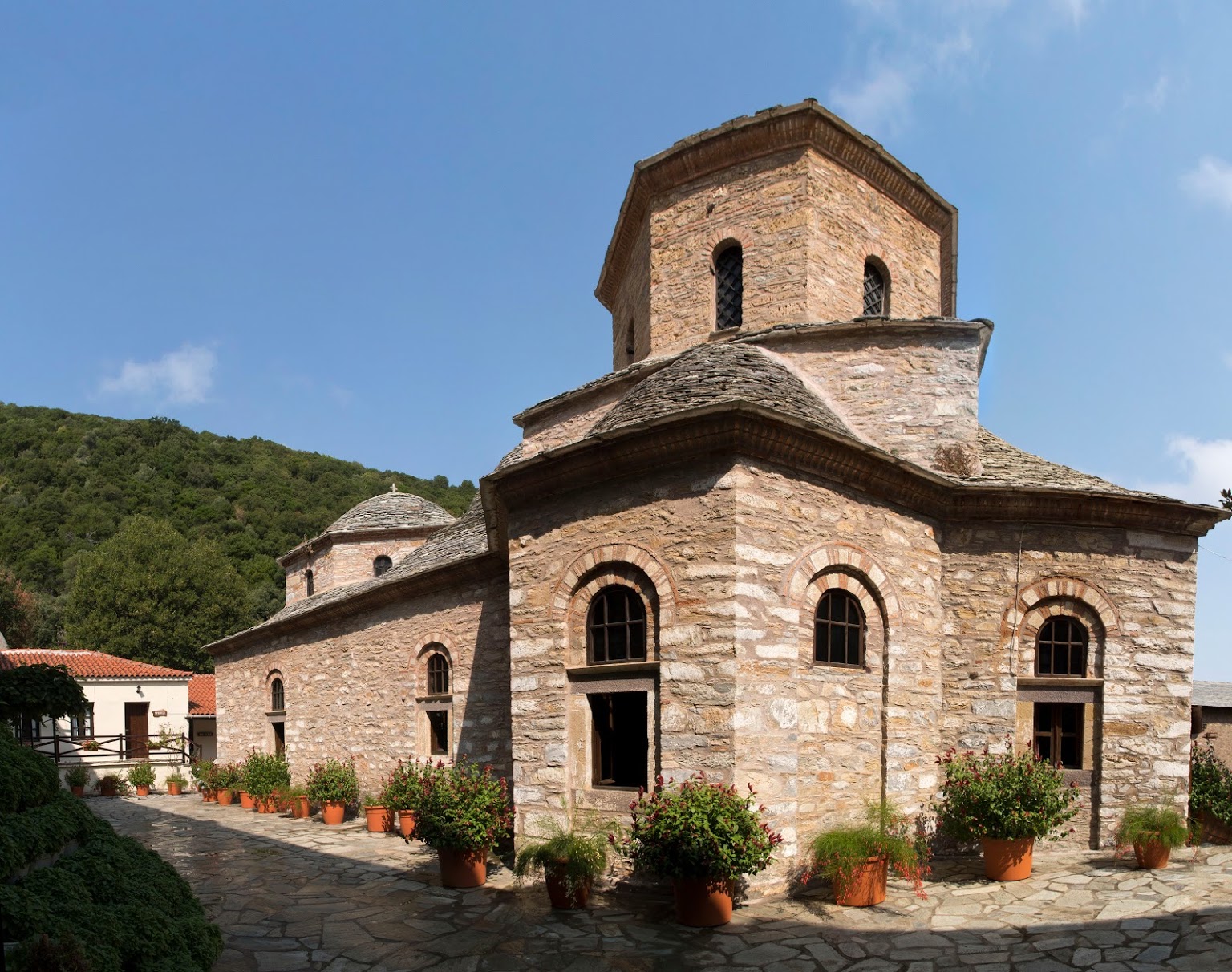The Holy Monastery of Evangelistria
The Monastery’s reconstruction was initiated in 1794 and completed in 1806 by a small group of monks, from the “Kolivades” movement, that had come to the island from Mount Athos. Kolivades’ monks had a heavy impact on the locals’ everyday lives. Additionally, their contribution to the historic revolution of 1821 was very significant.
The leading figure of the group was monk ‘Nifon’, who was born in 1736 on Chios Island. Saint Nifon founded, on the island of Ikaria, in 1775, the Holy Monastery of Evaggelistria. There, there was a monk named Grigorios Xatzistamatis, who was born on Skiathos and had inherited a huge amount of fortune from his father. Having that in mind, Grigorios urged and, finally, convinced Saint Nifon to leave Ikaria, move to Skiathos and rebuild the Holy Monastery of Evaggelistria.
As happens with every monastery on Skiathos Island, the Holy Monastery played a crucial role in locals’ lives. In fact, Alexandros Papadiamantis and his cousin Alexandros Moraitidis were strongly and positively influenced by it, as it helped them embrace and develop their religiousness and spirituality. Moreover, the importance of monasteries was, mainly, proved during the dark years of the Turkish rule, when lots of people turned to religion and God for hope and consolation.
Also, monasteries brought people closer to ‘Holy Mount Athos’ -and the church in general- by teaching them the church’s old customs and traditions. Only twelve years after its reconstruction, the monastery already hosted 65 cells, fortress walls, wings that consisted of three floors and more than 70 monks, who were highly praised for their moral virtue and education.
Saint Nifon passed away on the 28th of December, in 1809, at the age of 73. Of course, his co-founder and donator of his father’s fortune, Grigorios Xatzistamatis, was the one to serve as the second abbot of the Monastery, from 1809 to 1815.
Furthermore, the Monastery played a crucial role in the Revival Movement of 1821 as hundreds of warriors -from Thessalia and elsewhere- found shelter behind its massive walls. Also, for the same period of time, the Monastery functioned as a food-supply center for the fighters. Additionally, during many war efforts that took place on the island, the monks provided help and safety to many women and children by hosting them inside their walls.
Another momentous fact regarding the Monastery is that it was the place where the very first Greek flag (blue background and a white cross) was designed, woven and raised by the leaders of the Revolution Andreas Miaoulis, Nikotsaras and others, who took an oath to serve and protect their country. The flag was blessed by the Monastery in September 1807, in the presence of Theodoros Kolokotronis.
Today, it keeps a great number of sacred heirlooms, books and letters that are thought to be a “holy treasure”. Moreover, it also guards numerous sacred Saints’ remains, some of which were donated by admiral Lazaros Kountouriotis, in 1823, as a recognition of the Monastery’s assistance in the nation’s effort for liberation. Several of the above heirlooms are displayed at the Monastery’s museum for the public.
The Holy Monastery of Evaggelistria is considered to be one of the most precious and significant monuments, not only for Skiathos Island, but for the entire country as well. That is why many of its parts are constantly being rebuilt and conserved. Throughout the year, thousands of worshippers come to the island to visit this remarkable place, especially during the Holy Week and on the 15th of August, when the festivities are combined with feasts.
The Monastery offers a whole series of authentic, local products, all of which are harvested (from the island’s endless natural resources) and cooked by the monks themselves -always with the voluntary help of Skiathos’ people-, who guarantee the products’ highest quality. They are packaged and available for sale in a particular area inside the Monastery. All incomes are used for the Monastery’s support and maintenance.
A few meters away, on a small hill, you can find a traditional café, where you can relax and enjoy your coffee, as well as the magical view of the northern part of the island. If you are lucky and the atmosphere is crystal clear, you can overlook the great Mount Athos, too. After all, let us not forget that the etymology for the Greek word “Skiathos” means “the shadow of Mount Athos”.
As of 2010, the Monastery’s abbot is canon Father Joseph Katsouras. He was born in Skiathos and is well-known and beloved by all locals. Prior to canon Katsouras, abbots of the Monastery were canon Father Gerasimos Zouras (1957-1996) and canon Aggelos Lissaris (1998-2010) who, as Father Katsouras, offered more than enough for the Monastery’s reconstruction, restoration and general functioning.


